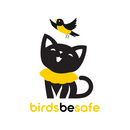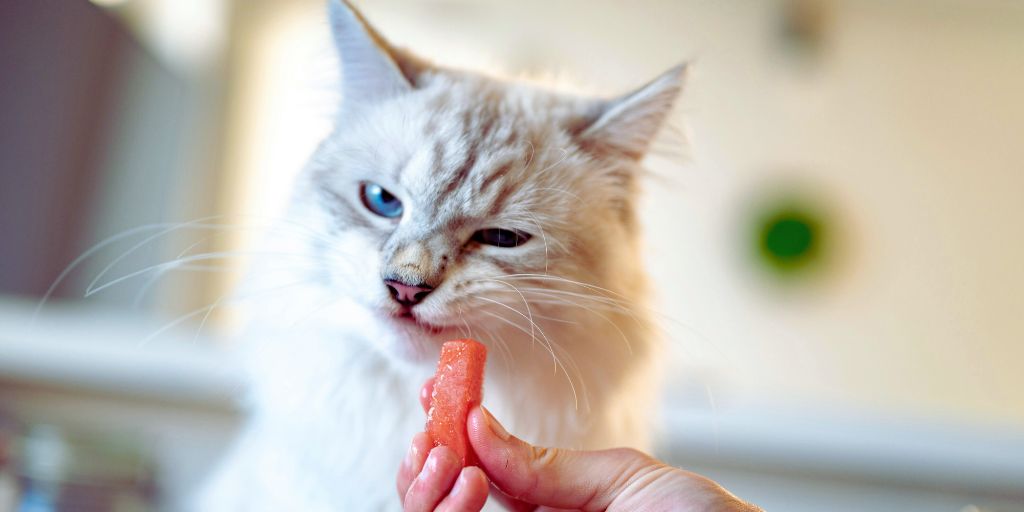Photo by Piotr Musioł on Unsplash
Cats are curious by nature. If you’ve ever sat down with a plate of food, you’ve probably noticed your furry shadow sneaking closer, nose twitching, eyes fixed on whatever you’re eating. Some cats will paw at your plate, others will meow until you share a bite. But here’s the tricky part: not everything we humans enjoy is safe, or even remotely healthy, for our feline friends.
As pet parents, it can be hard to know where to draw the line. Certain human foods are perfectly harmless in small amounts, while others can cause serious health problems. Fruits, vegetables, sweets, dairy—cats may want to try them all, but that doesn’t mean they should. And one of the most common questions owners ask is: Can cats eat watermelon?
That bright, juicy summer fruit looks harmless enough, but does it really belong in a cat’s diet? Before you slide over a bite, let’s explore the bigger picture: what our feline friends can eat, what they can’t, and how to tell the difference.
- Can Cats Eat Watermelon? Here’s What to Know
- What Other Fruits Can Cats Eat?
- Foods Cats Should Never Eat
- What to Do if Your Cat Eats Something Unsafe
- From Diet to Hunting: Why Eating Habits Matter (and How BirdsBeSafe Collars Help)
- Caring for Cats, One Choice at a Time
Can Cats Eat Watermelon? Here’s What to Know
A sweet, seedless nibble of watermelon makes a refreshing treat for your curious cat.
Photo by Piotr Musioł on Unsplash
The short answer is yes—but only under certain conditions, and only in moderation. Let’s dig into the potential benefits, risks, and safe ways to share this juicy fruit with your feline friend.
Nutritional Benefits of Watermelon for Cats
Watermelon is about 92% water, making it a refreshing option for hydration. For cats that don’t drink much from their bowl, a tiny piece of watermelon can help. It also contains:
- Vitamin C and Vitamin A (antioxidants for good health)
- Potassium (supports heart and muscle function)
- Fiber (aids digestion, but too much may cause an upset stomach)
That said, while watermelon is healthy for humans, it’s not particularly good for cats in terms of nutrition. Cats are obligate carnivores, meaning they thrive on protein-rich animal products. Plant foods like watermelon are not essential, so think of it as a snack, not a diet staple.
Risks: Seeds, Rind, and Sugar
Not all parts of the fruit are safe. Here’s what to avoid:
- Seeds – Many pet parents ask: Can cats eat watermelon seeds? The answer is no. All the seeds should be removed, as they can pose a choking hazard, cause blockages, and even contain trace cyanide compounds.
- Rind – Can cats eat watermelon rind? The answer is also no. The rind is tough to digest and often causes stomach upset.
- Sugar content – While the flesh is safe, the sugar content can be a concern for overweight or diabetic cats. Too much sugar, even from fruit, can cause spikes in blood glucose.
How to Safely Feed Watermelon to Cats
If you want your cat to safely eat watermelon, follow these steps:
- Remove the rind and watermelon seeds completely
- Cut into tiny, bite-sized pieces
- Offer only as an occasional treat (once or twice a week)
- Keep treats (including fruit) under 10% of daily calories
- Watch for negative reactions like vomiting or diarrhea
👉 Can kittens eat watermelon? Not recommended. Young cats have developing digestive systems and need calories from high-quality protein, not sugar-filled fruit.
How Much Watermelon Can Cats Eat?
A single cube of seedless red flesh is plenty. Feeding large quantities increases the risk of sugar overload or digestive upset.
What Other Fruits Can Cats Eat?
Besides watermelon, cats may also enjoy small bites of safe fruits like bananas, strawberries, and blueberries (in moderation, of course!).
Watermelon isn’t the only fruit on the “safe in moderation” list. While cats don’t have a sweet tooth like humans (they lack the taste receptors for sugar), some still enjoy the texture and juiciness of fruit. Sharing a small bite can be a fun way to bond, as long as you keep safety in mind. Here are some options:
- Blueberries – Rich in antioxidants and water, they make a hydrating, bite-sized snack.
- Apples (without seeds or core) – Offer crunch and fiber, but always remove seeds since they contain cyanide compounds.
- Bananas – A soft, easy-to-digest option, though their sugar content means they should be given sparingly.
- Strawberries – Packed with vitamin C and fiber, but serve only in tiny amounts due to sugar.
- Cantaloupe and honeydew – Many cats seem drawn to the scent; just remove the rind and seeds first.
Always introduce watermelon and other new foods slowly and in very small amounts. Watch for signs of gastrointestinal upset like vomiting or diarrhea. If your cat reacts negatively, stop feeding that fruit right away.
Foods Cats Should Never Eat
When it comes to keeping your cat safe, knowing what not to feed is just as important as offering the right treats. Some foods that are perfectly fine for humans—or even dogs—can be harmful or downright deadly for cats. Even a small amount of the wrong food, especially those with too much sugar, can trigger health problems, from mild digestive issues to organ failure. Pet parents should always stay alert and keep these items out of reach.
Here are the big ones to watch out for:
- Onions, garlic, and chives – These can damage red blood cells and lead to anemia. Even powdered forms used in soups or baby food are dangerous.
- Grapes and raisins – Known to cause sudden kidney failure in cats, even in small amounts.
- Citrus fruits (lemons, limes, oranges, grapefruit) – Contain essential oils and citric acid that are toxic to cats
- Cherries – The pits, stems, and leaves contain cyanide compounds
- Chocolate and caffeine – Contain theobromine and caffeine, both highly toxic to cats and capable of causing tremors, seizures, or even death.
- Xylitol – A sugar substitute found in many sugar-free gums, candies, and some peanut butters. It can cause insulin spikes, leading to liver failure.
- Alcohol – Just a sip of beer, wine, or spirits can depress the nervous system and be fatal.
- Raw dough with yeast – Expands in the stomach and produces alcohol as it ferments, posing a double threat.
- Certain bones and fatty scraps – Cooked bones can splinter and puncture the digestive tract, while excess fat may trigger pancreatitis.
If you’re ever unsure, it’s safest to avoid sharing human foods altogether and stick with vet-approved healthy cat treats. When accidents happen, call your vet or the ASPCA Animal Poison Control Center right away.
What to Do if Your Cat Eats Something Unsafe
Even the most careful fur parents can’t always prevent accidents. If your cat manages to sneak a bite of something dangerous, staying calm and acting quickly can make all the difference.
Here’s what you should do:
- Identify what was eaten – Check the food label, ingredients, or leftovers to confirm exactly what your cat ingested.
- Estimate the amount – A tiny lick may be less dangerous than a full bite, but any exposure to toxic foods should be taken seriously.
- Watch for symptoms – Vomiting, diarrhea, drooling, weakness, tremors, or difficulty breathing are red flags.
- Call your veterinarian immediately – Describe what your cat ate, when it happened, and any symptoms you’re seeing.
- Contact the ASPCA Animal Poison Control Center if your vet isn’t available.
- Don’t try home remedies unless directed by a vet – For example, inducing vomiting can sometimes make things worse.
The best prevention is keeping harmful human foods out of reach. But if accidents happen, fast action can protect your cat’s health and even save their life. Having pet insurance plans in place can also provide peace of mind and help cover unexpected vet bills if emergencies arise.
From Diet to Hunting: Why Eating Habits Matter (and How BirdsBeSafe Collars Help)
Cats are natural hunters, no matter how well-fed they are. Even if you provide the perfect, balanced diet and the tastiest treats, those instincts don’t just disappear. For many cats, eating habits indoors are tied directly to their behavior outdoors. A cat that snacks frequently but lacks enrichment may still wander outside to stalk birds, not because they’re hungry, but because their instincts drive them to hunt.
This is where BirdsBeSafe collar covers come into play. These brightly colored fabric covers fit over a cat’s collar and act like a warning flag for birds, making your feline friend more visible and giving birds a better chance to escape. Studies show that cats wearing BirdsBeSafe collar covers catch significantly fewer birds, helping protect wildlife without limiting your cat’s freedom.
By keeping your cat’s nutritional needs met indoors with the right mix of protein-rich food, occasional healthy treats, and stimulating play, you reduce the urge to hunt. And for cats that do venture outside, pairing those habits with a BirdsBeSafe collar cover can strike a balance between honoring their instincts and protecting the environment.
Caring for Cats, One Choice at a Time
Sharing food with our cats often feels like sharing love. A nibble here, a treat there—it’s one of the ways we connect. But at the heart of it, what truly matters is keeping our felines healthy, safe, and thriving. Every choice we make, from the snacks we offer to the toys we buy, shapes their little world.
Food is only one part of the bigger picture. Playtime, enrichment, and even small steps—like using a BirdsBeSafe collar cover if your cat goes outside—help them live fuller, richer lives while protecting the world around them.
At the end of the day, being a pet parent isn’t about perfection. It’s about paying attention, learning as we go, and making choices that keep our companions close to us for as many happy years as possible. Because they’re not just pets—they’re family.

















